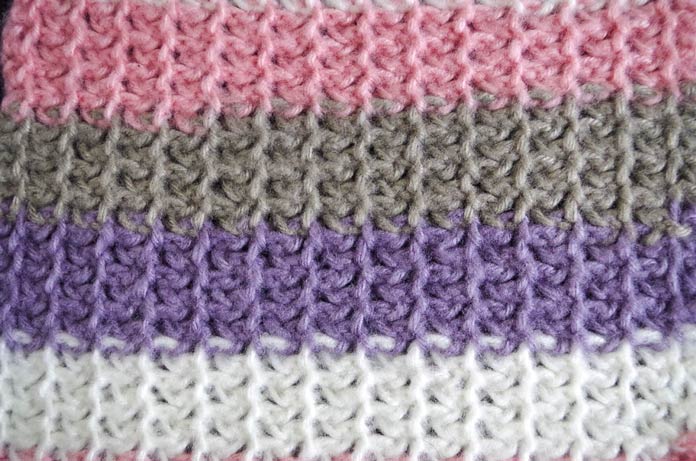Knitting with fuzzy yarn like Red Heart Dreamy Stripes inspires me to find stitch textures that have a lace-like effect without always being yarn-over eyelets. Bi-directional herringbone is such a stitch pattern because the fuzziness fills the smaller lace holes and the diagonal strands also catch the light and the halo is intensified.

The soft pastels of this colorway of Dreamy Stripes suit the bi-directional herringbone stitch pattern very well.
The bi-directional herringbone stitch pattern is great for a balanced fabric that stretches well four ways. The vertical stretch is the best, but the diagonal strands draw the knit back to its original shape. Stretching in either diagonal direction has a similar effect, but is slightly more resistant. Horizontally, the fabric does stretch some, but the give isn’t as generous as the vertical. I wouldn’t recommend this stitch for socks or yokes because the give isn’t flexible enough.

The transitions between the stripes are not 100% abrupt. The colors overlap for about 2″. The tones of the colors are well-suited to each other, too.
This stitch pattern doesn’t yield fabric that is the same on both sides, but regardless, the “wrong side” is equally pretty. In my books, that makes this a reversible stitch pattern.

The “private” side of the bi-directional herringbone stitch pattern is equally lovely, with it’s splayed columns stitches and slightly crocheted appearance.
How to knit the bi-directional herringbone stitch
Stitches & Abbreviations
K = knit; RS = right side; yo = yarn over; sl1pw = slip 1 purlwise; psso = pass slipped stitch over (in this case 2 stitches); p = purl; WS = wrong side; rep = repeat; p2tog = purl 2 together; LH = left-hand; st(s) = stitch(es).
Instructions
With US10.5 [6.5mm] needles, cast on a multiple of 3 stitches, plus 1. This swatch was knit over 46 stitches and is 9″ wide.
Row 1 (RS): K1, *yo, sl1pw, k2, psso2sts; rep from * across.
Row 2: P1, *yo, sl1pw, p2, psso2sts; rep from * across.
Rep Rows 1 and 2 for pattern, ending with a Row 1.
Bind off row (WS): *P2tog, slip st back to LH needle; rep from * across.

Knit a scarf or cowl with 1 ball of Red Heart Dreamy Stripes.
With 46 stitches and a gauge of approximately 20 sts per 4″, and 1 ball of Red Heart Dreamy Stripes, you’ll be able to knit a scarf that’s 55″ long x 9″ wide. I hope you give this stitch pattern a try.
This is part 1 of 5 in this series.
Go to part 2: Fleck stitch knitted in Super Saver Pooling
[shareaholic app=”follow_buttons” id=”23784471″]
